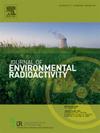Assessment of the cesium-137 concentration in algae-grazing ayu Plecoglossus altivelis collected from Tomioka River in Fukushima, Japan
IF 2.1
3区 环境科学与生态学
Q3 ENVIRONMENTAL SCIENCES
引用次数: 0
Abstract
Large amounts of the cesium-137 (137Cs) released into the atmosphere during the Fukushima Dai-ichi Nuclear Power Plant accident in March 2011 had deposited on land, especially in Fukushima Prefecture. The long-term persistent 137Cs contamination of freshwater fish has resulted in fishing activities being restricted or suspended in some rivers and lakes, mainly in the central to eastern areas of Fukushima Prefecture. The ayu Plecoglossus altivelis, an important inland resource in Japan, is one of the species for which fishing activities are suspended. This fish feeds on periphytic algae attached to riverbed stones, ingesting fine sediments along with the algae. Although whole-body monitoring of ayu has been conducted, whether they contain the 137Cs concentration that allows the resumption of fishing activities is difficult to ascertain because the 137Cs in fine sediments affects the concentration in the whole fish body. Therefore, in this study, substances (refractory portion) affecting the whole-body 137Cs concentration were removed to gain an accurate assessment of the actual concentration. We measured the 137Cs concentrations in the muscle, head, and internal organs of ayu individuals collected from Tomioka River in Fukushima in May and October 2022 and reconstructed the whole-body 137Cs concentration from those measurements. Through H2O2–HNO3 digestion of the fish and microalgae, we also measured the 137Cs concentrations in the refractory portions that affect the whole-body measurement. The percentages of non-digested fish with whole-body 137Cs concentrations exceeding the Japanese regulatory limit were 18.0 % in May and 50.0 % in October. By contrast, when the refractory portions were removed, none of the specimens showed whole-body 137Cs concentrations that exceeded the limit. These findings suggest that the procedure for monitoring 137Cs in ayu should be reviewed.
日本福岛富冈河食藻ayu Plecoglossus altivelis中铯-137浓度的评估
2011年3月福岛第一核电站事故期间释放到大气中的大量铯-137 (137Cs)沉积在陆地上,特别是在福岛县。淡水鱼长期持续受到137Cs污染,导致一些河流和湖泊的捕鱼活动受到限制或暂停,主要是在福岛县中部和东部地区。ayu Plecoglossus altivelis是日本重要的内陆资源,也是暂停捕捞的物种之一。这种鱼以附着在河床石头上的周围生长的藻类为食,随着藻类一起摄入细小的沉积物。虽然对阿育鱼进行了全身监测,但由于细沉积物中的137Cs会影响整个鱼体的浓度,因此很难确定它们是否含有可以恢复捕捞活动的137Cs浓度。因此,在本研究中,去除影响全身137Cs浓度的物质(难降解部分),以获得准确的实际浓度评估。我们测量了2022年5月和10月在福岛富冈河采集的ayu个体肌肉、头部和内脏中的137Cs浓度,并根据这些测量结果重建了全身137Cs浓度。通过对鱼类和微藻的H2O2-HNO3消化,我们还测量了影响全身测量的难降解部分的137Cs浓度。全鱼137Cs浓度超标的未消化鱼在5月和10月分别为18.0%和50.0%。相比之下,当去除耐火部分时,没有一个样品显示出全身137Cs浓度超标。这些发现表明,应重新审查ayu中137Cs的监测程序。
本文章由计算机程序翻译,如有差异,请以英文原文为准。
求助全文
约1分钟内获得全文
求助全文
来源期刊

Journal of environmental radioactivity
环境科学-环境科学
CiteScore
4.70
自引率
13.00%
发文量
209
审稿时长
73 days
期刊介绍:
The Journal of Environmental Radioactivity provides a coherent international forum for publication of original research or review papers on any aspect of the occurrence of radioactivity in natural systems.
Relevant subject areas range from applications of environmental radionuclides as mechanistic or timescale tracers of natural processes to assessments of the radioecological or radiological effects of ambient radioactivity. Papers deal with naturally occurring nuclides or with those created and released by man through nuclear weapons manufacture and testing, energy production, fuel-cycle technology, etc. Reports on radioactivity in the oceans, sediments, rivers, lakes, groundwaters, soils, atmosphere and all divisions of the biosphere are welcomed, but these should not simply be of a monitoring nature unless the data are particularly innovative.
 求助内容:
求助内容: 应助结果提醒方式:
应助结果提醒方式:


